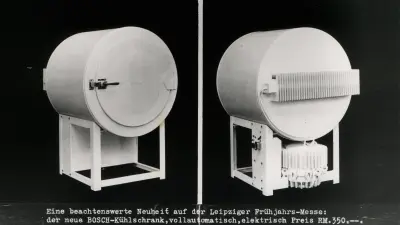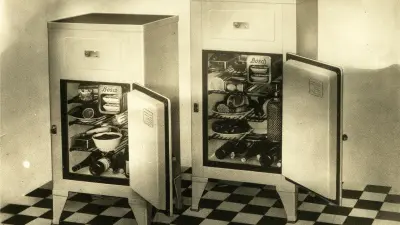The first Bosch refrigerator: A helping hand in every kitchen

Practical, elegant, and full of character. That was how advertising from 1933 introduced the latest Bosch product — the electric refrigerator.
The model unveiled at the Leipzig spring trade fair stood out from competitors’ refrigerators mainly because of its rounded drum shape. This new domestic appliance certainly offered a whole range of benefits.
However, it did not achieve success as quickly as the numerous refrigerator manufacturers of the late 1920’s and early 1930’s would have liked.
At that time, only a very small number of households could afford an electric refrigerator and the monthly power bills. Consumers also often had reservations about “unnecessary and dangerous” electrical household appliances.


The first domestic refrigerators were manufactured in the U.S. around 1910 and sold well. As a result, over the following years, numerous companies around the world ventured into the production of refrigerators. Bosch decided to launch its own electric refrigerator onto the market in 1929. The move onto the household appliances market formed also part of the diversification strategy that sought to reduce the company’s dependency on what had previously been its sole area of operation, automotive technology. As the electric refrigerator was still a luxury in Europe and Germany, and a long way from becoming a mass product, Bosch set itself the task of developing and launching a machine for the average consumer.
Its engineers came up with a compact refrigerator with a capacity of 60 liters, which would also fit into small kitchens. Technical factors meant that a rounded drum shape was cheaper to manufacture than square chests, and also enabled a more energy-efficient design for the refrigeration system. Although its price of 350 reichsmarks was comparatively low, the refrigerator was nonetheless still beyond the reach of most households.
“Go for it – it’s well worthwhile!”
Thanks to its striking look, the 1933 Bosch refrigerator soon became a well-known appliance. Extensive advertising campaigns raised its profile even further. One of the first advertising leaflets for the Bosch refrigerator extolled the virtues of electrical refrigeration:
“Modern housewives have long dreamt of using fully automatic refrigeration to run the home more economically, to keep all types of food and drink fresh for long periods, to contribute to an even greater sense of well-being and contentment in the home, and to be the very best of hosts without great effort or cost.” In short: “The ingeniously designed electric refrigerator from Bosch helps you achieve a thoroughly modern lifestyle!”

From round to square
A successful product development had been born. Once it became clear that opinion was divided on both the esthetic appearance and effectiveness of the round model, the product planners reacted quickly. The subsequent appliances from 1935 and 1936 used the classic square cabinet shape and had a much larger capacity of 90 and 120 liters respectively.
The technology was continuously improved, with ever more convenient additions being made to subsequent models. By 1938/39, Bosch refrigerators boasted interior lighting and height-adjustable shelves. In the 1950s, refrigerator production finally got into full swing. The Bosch refrigerator became the “helping hand in every kitchen”.
Author: Bettina Simon
